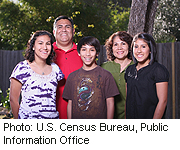
FRIDAY, May 25 (HealthDay News) — Only one in 14 Hispanic adults in the United States has ever been screened for skin cancer, far fewer than the one in four whites screened, a new study finds.
Socioeconomic factors such as lack of health insurance and poorer access to health care services are major reasons for this disparity, according to the researchers at The Cancer Institute of New Jersey.
They added that their findings show the need to develop ways to promote skin examinations among Hispanics at risk for skin cancer.
Previous research has shown that while Hispanics are at lower risk of melanoma than whites, Hispanics are more likely than whites to be diagnosed at an earlier age and with thicker, more advanced melanoma, the most deadly type of skin cancer. Studies have also shown that full-body, head-to-toe skin examinations by a doctor may reduce the incidence of thick melanomas that have a poor prognosis.
In this new study, the researchers analyzed data from more than 4,700 Hispanic adults who took part in the 2010 U.S. National Health Interview Survey. Only 7 percent of the adults reported ever having a full skin examination by a doctor.
When broken down by categories, rates of full-body skin examinations for Hispanics were: 9 percent for those born in the United States; 6 percent for those born outside the U.S.; 4 percent for those who spoke mostly or only Spanish; 13 percent for those of Cuban descent; 10 percent for those of Puerto Rican descent; and 6 percent for those from Mexico and the Dominican Republic.
Lower screening rates were seen among: men (6 percent); people aged 18 to 29 (4 percent); those with some high school education or less (4 percent); people without health insurance (3 percent); those with no source of preventive care (2 percent); and people who received preventive care somewhere other than a doctor’s office (5 percent).
The study appeared in the latest issue of the Archives of Dermatology.
“Although the skin cancer screening rates were higher for several Hispanic subpopulations, the overall rate of screening we found among adult U.S. Hispanics was very low,” lead author Elliot Coups, a behavioral scientist at the Cancer Institute of New Jersey and an associate professor of medicine at University of Medicine and Dentistry of New Jersey-Robert Wood Johnson Medical School, said in an institute news release.
“It is of concern that Hispanic individuals with a language barrier, lower level of education and lack of access to health care had especially low screening rates. While additional research is needed, it is clear from this study that this population may greatly benefit from interventions that promote these screenings, particularly for individuals at risk for skin cancer,” he concluded.
More information
The U.S. National Cancer Institute has more about skin cancer screening.

